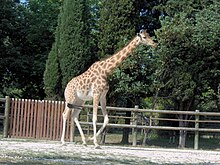Kordofan giraffe: Difference between revisions
No edit summary |
Undid revision 839477358 by 161.97.190.74 (talk) rv taxonomy crusader |
||
| Line 12: | Line 12: | ||
}} |
}} |
||
The '''Kordofan giraffe''' (''Giraffa camelopardalis antiquorum'') is a [[subspecies]] of [[ |
The '''Kordofan giraffe''' (''Giraffa camelopardalis antiquorum'') is a [[subspecies]] of [[giraffe]] found in [[northern Cameroon]], southern [[Chad]], [[Central African Republic]] and possibly [[western Sudan]].<ref name=range>{{cite journal | url=https://www.academia.edu/458858/Mitochondrial_DNA_Variability_In_Giraffa_camelopardalis_Consequences_for_Taxonomy_Phylogeography_and_Conservation_of_Giraffes_In_West_and_Central_Africa | title=Mitochondrial DNA variability in Giraffa camelopardalis: consequences for taxonomy, phylogeography and conservation of giraffes in West and central Africa | author=Hassanin, A., A. Ropiquet, A. L. Gourmand, B. Chardonnet and J. Rigoulet | journal={{Interlanguage link multi|Comptes Rendus Biologies|fr}} | year=2007 | issue=330 | pages=265–274 | doi=10.1016/j.crvi.2007.02.008 | pmid=17434121 | ISSN=1631-0691}}</ref> Historically some confusion has existed over the exact range limit of this subspecies compared to the [[West African giraffe]], with populations in e.g. northern Cameroon formerly assigned to the latter.<ref name=range/> [[Genetics|Genetic]] work has also revealed that all "West African giraffe" in European [[zoo]]s are in fact Kordofan giraffe.<ref name=range/> Compared to most other subspecies, the Kordofan giraffe is relatively small at 5 to 6 meters,<ref>{{Cite web|url=http://www.wild-about-you.com/GameKordofanGiraffe.htm|title=Kordofan Giraffe|website=www.wild-about-you.com|access-date=2018-01-31}}</ref> with more irregular spots on the inner legs. Its English name is a reference to [[Kordofan]] in Sudan. There are around 2,000 individuals living in the wild. |
||
''[[The Christian Science Monitor]]'' lists only 38 individuals being alive in the embattled [[Garamba National Park]] in [[The Democratic Republic of Congo]] due to poaching; their skin is used for luxury goods and they are said to produce enough meat to feed poachers for 'weeks'.<ref name="DMO">{{cite news | url=http://www.dailymail.co.uk/sciencetech/article-3452284/Tiny-Kordofan-giraffes-brink-extinction-Congo-population-drops-just-38.html | title=Kordofan giraffes on the brink of extinction in the Congo after hunting has caused the population to drop to just 38 | work=[[Daily Mail Online]] | date=February 29, 2016 | accessdate=November 15, 2016 | author=Woollaston, Victoria}}</ref> Recent genetic studies also shows distinct [[genetic populations]] of giraffe that makes conservation of these subspecies even more important.<ref>{{cite web |url=http://www.csmonitor.com/Environment/2016/0228/Why-is-this-rare-giraffe-almost-extinct |title=Why is this rare giraffe almost extinct? |last1=Hinckley |first1=Story |last2= |first2= |date=28 February 2016 |website=[[The Christian Science Monitor]] |publisher= |access-date=11 September 2016 |quote=}}</ref> |
''[[The Christian Science Monitor]]'' lists only 38 individuals being alive in the embattled [[Garamba National Park]] in [[The Democratic Republic of Congo]] due to poaching; their skin is used for luxury goods and they are said to produce enough meat to feed poachers for 'weeks'.<ref name="DMO">{{cite news | url=http://www.dailymail.co.uk/sciencetech/article-3452284/Tiny-Kordofan-giraffes-brink-extinction-Congo-population-drops-just-38.html | title=Kordofan giraffes on the brink of extinction in the Congo after hunting has caused the population to drop to just 38 | work=[[Daily Mail Online]] | date=February 29, 2016 | accessdate=November 15, 2016 | author=Woollaston, Victoria}}</ref> Recent genetic studies also shows distinct [[genetic populations]] of giraffe that makes conservation of these subspecies even more important.<ref>{{cite web |url=http://www.csmonitor.com/Environment/2016/0228/Why-is-this-rare-giraffe-almost-extinct |title=Why is this rare giraffe almost extinct? |last1=Hinckley |first1=Story |last2= |first2= |date=28 February 2016 |website=[[The Christian Science Monitor]] |publisher= |access-date=11 September 2016 |quote=}}</ref> |
||
Revision as of 18:36, 3 May 2018
| Kordofan giraffe | |
|---|---|

| |
| Kordofan giraffe in Vincennes Zoo, Paris | |
| Scientific classification | |
| Domain: | Eukaryota |
| Kingdom: | Animalia |
| Phylum: | Chordata |
| Class: | Mammalia |
| Order: | Artiodactyla |
| Family: | Giraffidae |
| Genus: | Giraffa |
| Species: | |
| Subspecies: | G. c. antiquorum
|
| Trinomial name | |
| Giraffa camelopardalis antiquorum | |

| |
| Range map in teal | |
The Kordofan giraffe (Giraffa camelopardalis antiquorum) is a subspecies of giraffe found in northern Cameroon, southern Chad, Central African Republic and possibly western Sudan.[1] Historically some confusion has existed over the exact range limit of this subspecies compared to the West African giraffe, with populations in e.g. northern Cameroon formerly assigned to the latter.[1] Genetic work has also revealed that all "West African giraffe" in European zoos are in fact Kordofan giraffe.[1] Compared to most other subspecies, the Kordofan giraffe is relatively small at 5 to 6 meters,[2] with more irregular spots on the inner legs. Its English name is a reference to Kordofan in Sudan. There are around 2,000 individuals living in the wild.
The Christian Science Monitor lists only 38 individuals being alive in the embattled Garamba National Park in The Democratic Republic of Congo due to poaching; their skin is used for luxury goods and they are said to produce enough meat to feed poachers for 'weeks'.[3] Recent genetic studies also shows distinct genetic populations of giraffe that makes conservation of these subspecies even more important.[4]
References
- ^ a b c Hassanin, A., A. Ropiquet, A. L. Gourmand, B. Chardonnet and J. Rigoulet (2007). "Mitochondrial DNA variability in Giraffa camelopardalis: consequences for taxonomy, phylogeography and conservation of giraffes in West and central Africa". Comptes Rendus Biologies (330): 265–274. doi:10.1016/j.crvi.2007.02.008. ISSN 1631-0691. PMID 17434121.
{{cite journal}}: CS1 maint: multiple names: authors list (link) - ^ "Kordofan Giraffe". www.wild-about-you.com. Retrieved 2018-01-31.
- ^ Woollaston, Victoria (February 29, 2016). "Kordofan giraffes on the brink of extinction in the Congo after hunting has caused the population to drop to just 38". Daily Mail Online. Retrieved November 15, 2016.
- ^ Hinckley, Story (28 February 2016). "Why is this rare giraffe almost extinct?". The Christian Science Monitor. Retrieved 11 September 2016.
External links
 Media related to Kordofan Giraffes at Wikimedia Commons
Media related to Kordofan Giraffes at Wikimedia Commons Data related to Giraffa camelopardalis antiquorum at Wikispecies
Data related to Giraffa camelopardalis antiquorum at Wikispecies
